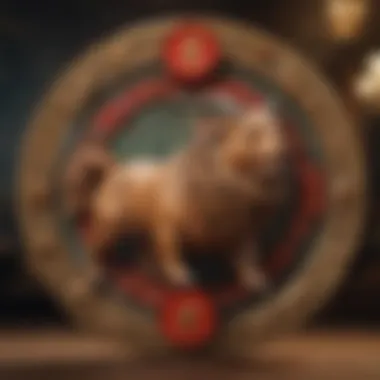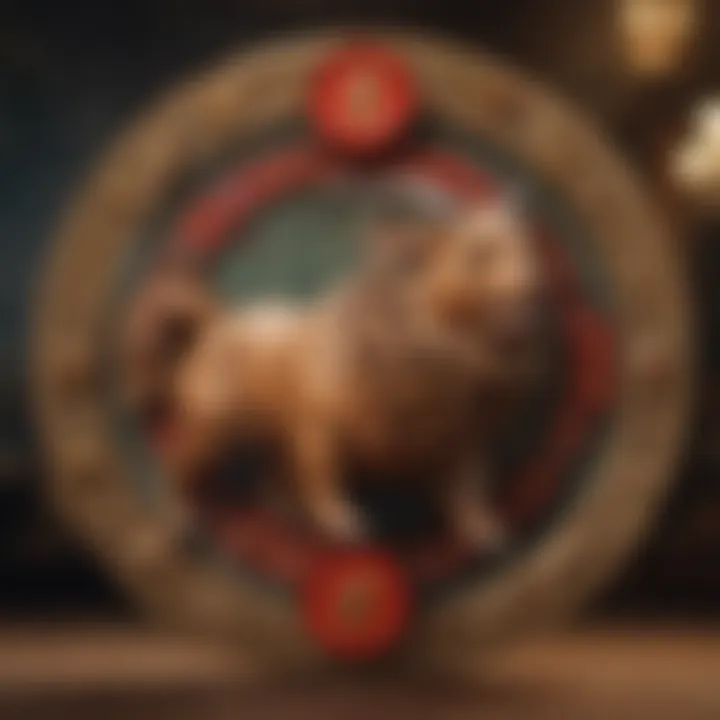Understanding the Chinese Birth Chart


Intro
The Chinese birth chart serves as a fascinating lens into understanding an individual's destiny through the intricate interplay of celestial influences, cultural traditions, and astrological philosophies. A well-rounded examination of this rich system reveals layers of meaning that are often eclipsed by more popular Western astrological practices. For those seeking to unlock the secrets that the heavenly bodies hold, diving into the depths of Chinese astrology becomes not just an exploration but a journey of personal and spiritual discovery.
Understanding the Zodiac
The Chinese zodiac, unlike its Western counterpart, is a twelve-year cycle where each year corresponds to a specific animal sign. These signs—Rat, Ox, Tiger, Rabbit, Dragon, Snake, Horse, Goat, Monkey, Rooster, Dog, and Pig—carry unique attributes that reflect varied aspects of personality and fate.
Overview of Zodiac Signs
Each sign embodies distinct qualities and characteristics, influencing how individuals perceive life and interact with others. Here’s a brief rundown:
- Rat: Smart and resourceful, often quick on their feet.
- Ox: Diligent and dependable, but can be stubborn.
- Tiger: Brave and competitive, with a zest for action.
- Rabbit: Peaceful and gentle, often adept at diplomacy.
- Dragon: charismatic and ambitious, tends to take charge.
- Snake: Wise and enigmatic, with a flair for the intuitive.
- Horse: Energetic and free-spirited, thrives on adventure.
- Goat: Creative and gentle, values harmony and beauty.
- Monkey: Playful and clever, loves to explore new ideas.
- Rooster: Observant and decisive, often a perfectionist.
- Dog: Loyal and friendly, but may be overly cautious.
- Pig: Generous and kind, with a love for life’s pleasures.
Sign Traits and Characteristics
Each animal sign feeds into a broader understanding of a person's nature. For instance, a person born under the Dragon might exhibit a high level of confidence, whereas one born in the year of the Pig could be more indulgent. This personalization helps to provide a framework for self-discovery and relationship dynamics.
Elemental Qualities
In addition to animal signs, the five elements—Wood, Fire, Earth, Metal, and Water—add another layer of depth to the analysis of the birth chart. Each element cycles through the years, amplifying or tempering the traits attributed to the animal sign. Consider how a Fire Horse may possess unmatched energy and assertiveness, while a Water Horse could reflect adaptability and emotional depth.
Astrological Insights
Understanding today's astrological landscape provides additional context when interpreting the Chinese birth chart.
Current Astrological Trends
Various cosmic events, including eclipses and planetary alignments, impact the collective energy felt globally. For example, a year marked by the assertive qualities of the Wood Element might yield transformations in personal or societal structures, urging a reconnection to earlier values.
Influence of Celestial Events
Celestial events, such as the Chinese New Year, serve as pivotal points for recalibrating energies. Celebrating the transition, whether through rituals or personal reflections, helps individuals align with the upcoming year's qualities, allowing the zodiac's influence to be more pronounced.
How to Interpret Your Birth Chart
Interpreting a birth chart requires both introspection and knowledge of astrological dynamics. Begin by noting your animal sign and its associated element. From there, exploring aspects like the complementary yin and yang energies within your chart aids in revealing inherent strengths and potential challenges. Also, consider analyzing interactions with other signs in your personal life, as these dynamics can illuminate important relationship aspects.
Horoscope and Predictions
Getting a feel for what lies ahead can be comforting and traditionally insightful.
Monthly or Weekly Forecasts
Astrology practitioners often offer forecasts that correspond to the cycles within the Chinese zodiac. These forecasts highlight opportunities or challenges in the coming month based on the overall energy present.
Personalized Horoscope Reading
By delving deeper into individual birth charts, astrologers can create personalized readings, which may include the analysis of unique planetary placements alongside the primary zodiac animal. This thorough approach uncovers deeper insights into one's journey and potential outcomes.
Compatibility Readings based on Zodiac signs
One captivating aspect of astrology is its role in discerning relationship compatibility. The combination of animal signs can yield fascinating insights. For example, a Tiger might find a harmonious bond with a Pig but not so easily with a Snake, shedding light on potential areas for growth or discomfort.
Astrology, both ancient and modern, serves as a mirror, reflecting our potential and aligning us with the universe's rhythm.
In summary, understanding the depth of the Chinese birth chart invites individuals to navigate the pathways of their destinies with greater clarity. Armed with knowledge about zodiac signs, elemental influences, and astrological trends, readers gain perspective on their lives and relationships, helping them weave a more authentic narrative guided by the stars.
Prelims to Chinese Birth Charts
Chinese birth charts are a fascinating exploration into a person's destiny viewed through the lens of ancient philosophy and astrology. This system is deeply engrained in Chinese culture, offering insights that go beyond the mere observation of planetary movements. Instead, it encompasses a holistic approach that integrates the twelve animal signs, five elements, and the yin-yang duality. Understanding these elements is pivotal not only for aspiring astrologers, but also for anyone looking to gain deeper insights into themselves or their loved ones.
The significance of Chinese birth charts extends far into personal and social realms. Birth charts can reveal intrinsic personality traits, potential career paths, and compatibility within relationships. This knowledge empowers individuals to make informed decisions in their lives, tapping into strengths and addressing weaknesses discovered through their charts.
Moreover, it’s important to recognize the careful consideration required when interpreting these charts. No two individuals share a chart in the same way, thanks in part to the unique interplay of the various components. Each chart serves as a map guiding us toward our true selves and potential. This section will serve as a foundation, introducing you to the essential themes and ideas that shape our understanding of Chinese birth charts.


Overview of Astrology in Chinese Culture
Astrology in Chinese culture is not merely an academic discipline; it’s a vibrant tapestry woven into the fabric of daily life. It resonates through festivals, traditional ceremonies, and personal milestones. For centuries, the Chinese have harnessed astrology to offer guidance and make predictions about various aspects of life. From choosing auspicious dates for weddings to determining the suitability of career paths, the principles of astrology find their way into many decisions, reflecting both cultural beliefs and practical applications.
The Chinese zodiac, comprising the twelve animal signs, is perhaps the most recognizable element of this astrological practice. Each sign corresponds to a year, cycling every twelve years, and is said to imbue those born in that year with certain characteristics and traits. This cyclical nature emphasizes how all things are connected and influenced by the cosmos.
Purpose and Importance of Birth Charts
Birth charts in the context of Chinese astrology carry profound importance. They serve as a personalized blueprint, revealing the potential trajectories one might follow throughout life. Not limited merely to personality insights, these charts also unveil the underlying forces of nature that govern life experiences.
Understanding one’s birth chart enhances self-awareness and personal growth. With a clear interpretation of animal signs, elemental influences, and the balance of yin and yang, individuals gain insights into their strengths and weaknesses. This can lead to greater harmonization within one’s environment.
The process of creating and interpreting these charts can be likened to a navigational tool. When you have your birth chart in hand, you possess a key that can unlock certain challenges and opportunities — aiding in everything from career choices to relationship dynamics.
"When one understands their birth chart, they don’t just glimpse into their future; they’re given a mirror reflecting their true self."
Ultimately, birth charts distill the complexities of life into a manageable format, allowing individuals to align their external actions with their internal callings. By shedding light on one�’s unique pathways, these charts foster an understanding of how to navigate the intricate dance of life.
Fundamentals of Chinese Astrological Principles
Understanding the basic principles of Chinese astrology serves as the cornerstone in exploring one’s birth chart. These foundational elements shape the interactions we observe in an individual’s chart and give insight into their psychological makeup, strengths, weaknesses, and potential life path. Not only do these principles provide a complex framework, but they also offer a unique lens through which to interpret life events and relationships, with notable concentration on the Twelve Animal Signs, the Five Elements, as well as the pivotal Yin and Yang concepts.
The Twelve Animal Signs
Characteristics of Each Sign
Each of the twelve animal signs embodies a set of characteristic traits. For instance, a Rat might be known for being clever and resourceful, while a Horse is often characterized by its freedom-loving nature. This uniqueness shapes the path of individuals born under these signs. The specific attributes each sign brings can significantly influence one’s personality, decision-making abilities, and even career choices. This uniqueness is crucial because it helps others understand individual tendencies better.
The most outstanding feature of these characteristics lies in their relevance to human behavior. Knowing one's sign can empower individuals to leverage positive traits while recognizing potential pitfalls. Moreover, understanding these signatures in diverse contexts enhances the integration of traditional wisdom into modern settings. Thus, the assessment of one’s sign becomes more than a casual exploration—it's a vital part of self-reflection.
Cycles and Their Influence
In Chinese astrology, time operates not just linearly but cyclically, emphasizing the natural rhythms of life and human experience. Each sign is repeated every twelve years, along with an intricate relationship to various elements and seasons. The cyclical nature implies that individuals sharing the same sign will exhibit both similarities and differences based on their unique elemental and other astrological influences.
One striking aspect of cycles is how they reflect the notion of change. Each cycle offers a unique opportunity for growth or renewal, creating a narrative of progression. This makes it essential for astrologers and enthusiasts alike to reflect on significant patterns observed in their own lives or the lives of those around them. Recognizing these cycles can lead to better decision-making and adaptability, enhancing one's ability to navigate life.
Compatibility Among Signs
Compatibility among the signs is an enchanting aspect, often explored to gauge the harmony in relationships—whether personal or professional. For example, the loveable nature of the Dog may complement the ambitious spirit of the Dragon, leading to compelling partnerships. The ingrained relationships can serve as a guideline for building successful and harmonious interactions.
What also stands out in this compatibility exploration is the cultural richness it fosters. Considering how partners navigate their traits brings about a deeper understanding of unions in context to various social constructs. Realizing that certain signs pair well and others might face challenges offers a holistic view of relationship building. Ultimately, compatibility transcends mere preferences, offering a roadmap toward meaningful connections.
The Five Elements Theory
Wood, Fire, Earth, Metal, Water
The Five Elements—Wood, Fire, Earth, Metal, and Water—create a framework that interlocks energy flows and emotional attunement within Chinese astrology. Each element carries its own traits and influences. For instance, Water nurtures emotions and adaptability, while Fire drives passion and creativity. As with animal signs, understanding one’s dominant element furnishes vivid insights into personal tendencies and character.
This elemental dimension greatly enhances the richness of the birth chart, integrating multiple layers of meaning. The nuances brought by the elements can clarify a myriad of experiences an individual may encounter. Recognizing and harnessing one's element thus stands as a powerful tool for self-discovery.
The Interactions Among Elements
Elements don’t merely exist in isolation; they interact in very dynamic ways. These interactions can be cooperative or conflicting, shaping the person’s energy landscape. For example, Wood can feed Fire, while Water can extinguish it. This interplay underscores the importance of balance in life and personal growth.
The key takeaway is that understanding these interactions can aid individuals in navigating challenges and fostering harmony in their existence. It brings a rich depth to the narrative of one's life, emphasizing constructive relationships and cautioning against dissonance that can arise from unbalanced interactions.
Balance of Elements in Reading
Finding balance among the Five Elements in an astrological reading becomes pivotal. A chart heavy in one element may indicate a propensity for certain challenges or strengths. Striking an equilibrium can enhance personal resilience and adaptive capabilities.
Emphasizing balance not only aids in comprehension of oneself but enhances relationships – social, romantic, and professional alike. Using elemental balance as a navigation tool reaffirms one’s ability to adjust and thrive within the dimensions of their life, transforming challenges into an opportunity for growth.
Yin and Yang Concepts
Understanding Yin and Yang
Yin and Yang, the dualities that underpin much of Chinese philosophical thought, plays an essential role in understanding one's birth chart. Yin represents the passive, the receptive, and embodies intuition, while Yang stands for action, assertiveness, and dynamism. Exploring one's balance of these forces helps in recognizing the dynamics at play within their lives.


The acknowledge of these concepts fosters a robust approach to introspection. It reveals intrinsic tendencies towards certain behaviors, guiding individuals to harness both sides of their nature. Therefore, understanding Yin and Yang enhances the capacity for self-acceptance and cultural appreciation.
The Role of Dualities in Astrology
In astrology, dualities reveal the inherent nature of both individuals and their relationships. For instance, understanding that an individual may possess a dominating Yin quality might offer insights into their preference for reflection and calm. Conversely, a Yang-driven person may exude a more energetic presence.
This duality framework not only helps in choosing compatible partnerships but also enhances one's self-awareness. It prompts the exploration of how various experiences might skew someone more toward Yin or Yang, showcasing the balance necessary for achieving fulfillment.
Yin/Yang Balance in Charts
Assessing how Yin and Yang balance presents a key analytical tool in interpreting a birth chart. When a chart shows a significant imbalance, it may indicate potential challenges, highlighting opportunities for growth. Thus, the interplay between the two energies not only informs identity but hints at possible life paths or obstacles.
Constructing a Chinese Birth Chart
Creating a Chinese birth chart is a cornerstone of understanding one's destiny in the context of Chinese astrology. This endeavor is not merely a superficial glance at astronomical positions; rather, it’s about decoding the rich tapestry of personal attributes, potentialities, and life paths rooted in ancient philosophies. The process involves meticulous calculation and interpretation, revealing insights into character, compatibility in relationships, and even career trajectories. By comprehensively engaging with each aspect of the chart, individuals can harness the wisdom of their astrological heritage.
Basic Components of the Chart
When constructing a Chinese birth chart, several essential components come into play. The chart fundamentally revolves around the Twelve Animal Signs that represent various personality traits and characteristics. Additionally, the Five Elements Theory—wood, fire, earth, metal, water—provides depth, relating to the elemental forces that shape an individual’s experiences and interactions. Finally, the interplay of Yin and Yang creates a balance that is vital for interpretation.
Each of these components serves as a unique piece of the puzzle, combining to offer a multi-faceted view of one's identity. Understanding each segment allows for a more rounded interpretation that aligns with personal inspirations and influences.
The Importance of Time and Date
The specificity of time and date in constructing a birth chart cannot be overstated. Each moment in time is associated with certain astrological nuances that carry weight in the final interpretation.
Calculating the Birth Year
Calculating the birth year is often the first step in the chart's construction. The year of birth correlates with one of the twelve animal signs. This sign acts as a guiding force, shaping essential traits within an individual. Knowing your birth year provides fundamental insight into personality and potential challenges. It is a significant choice for anyone exploring their chart due to its broad implications. The uniqueness of the birth year also allows for the connection of personal characteristics to collective energies influencing society during that period. However, it should be noted that while the year establishes a framework, it does not paint the whole picture.
Determining Month and Day
Following the calculation of the birth year, determining the month and day further refines one's chart. Each month aligns with specific elemental energies and animal characteristics, allowing for a deeper understanding of individual attributes. This component is particularly useful as it narrows down the interpretation significantly, providing more targeted insights into one’s personality and emotional landscape.
Through this layer of specificity, one can discern particular patterns in behavior and motivations that become apparent based on the influences of the connected month and day. Awareness of these factors can enhance personal growth, as understanding oneself on this level often leads to more insightful decision making. However, the challenge lies in the intricate connections between all these astrological markers.
The Role of the Hour in Charting
Finally, the hour of birth plays a crucial role in further defining one's chart. Often referred to as the "hidden animals," the hour corresponds to a secondary animal sign that provides additional depth to the primary personality characteristics derived from the birth year. This element adds layers of nuance that can illustrate softer aspects of one’s identity, including hidden talents or predispositions.
The hour of birth also captures the subtler energies emanating during that specific time, which can include fluctuating feelings and thoughts that might not be immediately obvious. Therefore, delving into this aspect allows for a more nuanced exploration of both strengths and weaknesses. It enriches the overall understanding of the individual’s experience as they navigate life’s paths.
"In Chinese astrology, each moment shapes destiny. The chart is a blueprint of the self, rich with insight if one knows how to decode it."
In summary, constructing a Chinese birth chart is a meticulous process requiring careful attention to the birth year, month, day, and hour. Each component interlocks to form a coherent narrative about individual purpose and potential. The quest for self-discovery through this astrological lens can be both profound and enlightening.
Interpreting Your Chinese Birth Chart
Interpreting your Chinese birth chart is akin to turning the pages of a complex novel about yourself - one filled with mysterious layers and profound insights. Each element of the chart acts like a whisper of your destiny, revealing the traits and tendencies that shape your character. Understanding this intricate tapestry is not just an exercise in curiosity; it offers invaluable perspectives on your life journey, helping to uncover personal strengths and weaknesses. In a world that often rushes forward, taking a moment to reflect on your birth chart can provide clarity and direction.
Reading the Animal Signs
The foundation of a Chinese birth chart lies in the twelve animal signs, each with its own distinct personality profile. For instance, the Rat, known for its cleverness and adaptability, might signal a life filled with opportunities, particularly in business ventures. Conversely, the Ox represents diligence and perseverance, marking someone destined for reliable progress.
When you read these signs, you not only see how they define the unique characteristics of an individual but also how they interact with one another. This interaction offers insight into your social dynamics, happiness in relationships, and even potential career paths. Often, those who align with their animal's strengths find greater fulfillment in their personal and professional lives.
Elemental Dominance in Charts
Moving beyond the animal signs, the five elements—Wood, Fire, Earth, Metal, and Water—also play a crucial role in shaping your birth chart. Each element contributes distinct qualities. For example, if Metal is dominant in your chart, you might demonstrate resilience and determination, yet could struggle with rigidity in thinking.
It's not merely about identification; understanding your elemental makeup unveils how much balance or imbalance there is in your life. A chart heavy in Fire, for instance, may require integrating more Water energy to prevent burnout and chaos. Recognizing these elemental influences enables you to harness their potential more effectively, guiding everyday decisions.
Assessing Yin and Yang Balance
Yin and Yang form the ultimate balancing act in Chinese philosophy, and your birth chart is no exception. A well-balanced chart embodies the harmony between these two energies, impacting emotional health, relationships, and life events. Too much Yin, say, might indicate an inclination toward introversion and passivity, while excessive Yang could lead to aggression and restlessness.
To assess this balance, examine the spread of elemental and animal influences in your chart. By reflecting on these relationships, it's possible to design a more harmonious existence. For example, if one’s Yin energy overshadows the Yang, activities that promote activity and assertiveness must be prioritized.


Remember: Your birth chart is a tool for growth and self-understanding; interpreting it is not a static conclusion, but an evolving journey.
Whether you choose to read your chart casually or delve deep into its complexities, the insights gained from interpreting these components can immensely shape your understanding of oneself. With each layer unfurling, the narrative of your life becomes clearer, helping pave the way for personal transformation.
Cultural Significance of Chinese Astrology
The cultural significance of Chinese astrology transcends mere horoscopes; it sits at the heart of societal structure, traditions, and personal identity. As a powerful tool rooted in ancient philosophy, it highlights the interconnectedness of individuals to the universe. Understanding this cultural backdrop is essential for anyone looking to delve into the nuances of a Chinese birth chart.
Historical Context and Evolution
Chinese astrology is not a recent phenomenon; it is steeped in history that dates back thousands of years. Emerging from the blend of mythological tales and astronomical observations, it continually evolved to reflect the changing tides of Chinese society. Initially, it was closely tied to agricultural cycles, aiding in crop successes and seasonal planning. For instance, during the Han Dynasty, astrology became a formal discipline, with scholars systematizing the twelve animal signs and their associated traits.
Over centuries, various dynasties have made contributions to astrological practices, from the Qin to the Ming. Each era influenced the interpretations of animal signs and elemental interactions, integrating regional beliefs and philosophies. Additionally, as the Chinese diaspora spread across the globe, the foundational concepts of astrology adapted to new cultures, demonstrating its resilience and adaptability.
"Chinese astrology is like a vast tapestry, each thread representing a moment in history, woven into the beliefs that shape us."
Influence on Personal and Social Decisions
The impact of Chinese astrology spills over into personal and collective decision-making. Families often consult their birth charts when establishing key moments like marriages, business ventures, or even naming children. Choosing auspicious dates based on one's animal sign or elemental balance is common, reflecting a desire to harmonize with cosmic forces.
In social contexts, individuals often gauge compatibility through their charts, impacting friendship, partnerships, and professional relationships. Here are a few key insights:
- Marriage Compatibility: Many prospective couples will analyze each other’s zodiac signs for compatibility, believing that certain pairings foster harmony while others yield conflict.
- Career Choices: Birth charts can offer insights into an individual's strengths and weaknesses, guiding career paths. For instance, someone governed by the Wood element may thrive in creative or nurturing roles.
- Daily Decisions: Many people rely on astrological forecasts to make everyday choices, such as travel, financial investments, or health plans, reflecting deeper beliefs in how celestial influences shape life.
Understanding the multifaceted role of astrology in society impacts how one interprets a birth chart. It emphasizes that these charts are not merely individualistic tools, but rather are woven into the communal fabric of Chinese culture, reflecting shared beliefs and values.
By appreciating this cultural significance, one can better navigate their own astrological journey, recognizing how it intertwines with the broader tapestry of life.
Practical Applications of Chinese Astrology
Chinese astrology isn't just about broad, sweeping generalizations that can sometimes feel distant from our day-to-day lives. Instead, it offers profound insights that are deeply embedded in practical applications, making it a valuable tool for individuals seeking a better understanding of themselves and their surroundings. By using one’s birth chart, people can tap into a treasure trove of knowledge that influences many aspects of life, providing guidance in choices and decisions. Here are some focal points where practical applications of Chinese astrology shine.
Using Birth Charts for Self-Discovery
Engaging with your Chinese birth chart can be like peeling an onion — layer by layer, more of oneself is revealed. The practice reflects one’s unique characteristics, revealing everything from innate strengths to areas that may require more nurturing and growth. A person born in the Year of the Dragon might feel a natural inclination towards leadership due to the fiery characteristics associated with that animal, while a person of the Sheep may carry a gentle, nurturing demeanor.
Self-discovery is often peppered with moments of revelation. As individuals analyze their charts, they can often connect dots that were previously obscure. They might think about why they react strongly in certain situations or why specific environments and people resonate more positively with them. It’s not just about reading your sign; it’s about seeing the full picture, akin to viewing an intricate tapestry rather than merely identifying a single thread.
"Understanding your birth chart is like holding up a mirror that reflects not just your surface, but the hidden depths of who you are."
Relationship Compatibility Assessments
Relationships can be complex, and sometimes it feels like there’s no science to finding a compatible partner. However, Chinese astrology provides a structured lens through which compatibility can be evaluated. Each animal sign interacts differently with others, often leading to harmonious pairings or challenging dynamics. For instance, a Rabbit paired with a Rooster may face hurdles, while a harmonious union between a Horse and a Tiger could flourish.
Consideration of elemental interactions further enriches these assessments. The dynamic of Fire and Metal, for example, might create sparks, but it could also result in conflicts if not managed with care. Analyzing compatibility not just on animal signs but also on elemental influences can lead to a heartier understanding of relationship dynamics. It allows individuals to approach partnerships with awareness, helping to avert potential pitfalls and build stronger bonds, giving people tools for navigating personal connections.
Navigating Career Paths and Opportunities
The wisdom offered by Chinese astrology can also be employed as a compass when it comes to career choices. Each sign has distinct professional inclinations that reflect their innate qualities. For instance, those born under the Monkey can demonstrate exceptional problem-solving skills; they thrive in dynamic environments that require adaptability. On the flip side, a Dog sign may be drawn towards roles that emphasize loyalty and service.
Moreover, aligning one’s career direction with elemental influences can also enhance success. An individual with strong Earth element influences may excel in fields like education or finance, where stability and support are critical. By understanding these nuanced intersections between signs and professions, individuals can make informed decisions that resonate with their true potential, allowing them to harness their strengths and pursue career paths that genuinely fulfill them.
Culmination
The conclusion of this article encapsulates the overarching themes and insights gleaned throughout the exploration of the Chinese birth chart. This unique astrological practice not only delves into the interconnectedness of various elements such as animal signs, the five elements, and the balancing act of yin and yang, but it also emphasizes the profound impact these factors have on personal destiny and interpersonal relationships.
Through careful interpretation of these charts, individuals can unlock significant self-awareness and understanding. By recognizing their elemental dominance or the nuances of their animal sign, individuals can harness their strengths and pinpoint areas needing development.
Recap of Key Insights
- Animal Signs: Each sign provides distinctive traits that can guide individuals in their personal and professional lives. For instance, a person born under the Rabbit sign might find it easier to nurture relationships, while someone from the Rooster sign may excel in leadership roles.
- The Five Elements: Understanding whether one is more aligned with Wood, Fire, Earth, Metal, or Water can shape choices in career paths, health regimes, and social dynamics, offering a practical edge to life decisions.
- Yin and Yang: The balance between these two forces is essential in fostering harmony within oneself and with others. A predominance of yin can suggest a need for more action, whereas an excess of yang might indicate a need for relaxation and introspection.
Overall, the topic of the Chinese birth chart is paramount. It illustrates how ancient wisdom can provide clarity in a modern context, aiding individuals in navigating through their life's various avenues.
Future Trends in Chinese Astrology
As we look forward, the integration of technology into astrological practices is poised to redefine how individuals interact with their birth charts. In this digital age, there is a noticeable shift toward personalized astrology apps that offer insights tailored to users in real-time. The access to vast astrological databases and community forums—like those found on Reddit and Facebook—facilitates discussions among enthusiasts and practitioners alike, fostering a renewed interest in ancient practices within contemporary frameworks.
Moreover, as globalization continues to blur cultural lines, there is an increasing blend of astrological systems; Western astrology is becoming intermingled with Chinese traditions. This hybridization has the potential to create innovative interpretations that draw from a diverse amalgamation of beliefs and insights.
Considering these trends, one might anticipate a rise in the use of machine learning algorithms to generate more accurate and personalized birth charts, ultimately allowing individuals deeper insights into their life paths.
"Astrology offers us a glimpse of the rich tapestry of life. By understanding our birth charts, we unravel our place within this cosmic design. "







